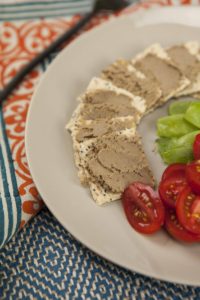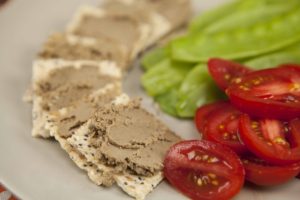 I recently became interested in consuming liver pate on a regular basis after my son’s major anaphylactic reaction back in December. A situation that was once under control felt as though it went spiraling through the roof and it prompted me to search for solutions to the problem. We’ve been working to enhance his digestion via probiotics, fermented foods, regular consumption of bone broth, and an anti-inflammatory diet free of grains, dairy, and sugar. The assistance of a handful of alternative care providers have also chimed in with their recommendations for varying herbs, vitamins, and supplements to help support the change.
I recently became interested in consuming liver pate on a regular basis after my son’s major anaphylactic reaction back in December. A situation that was once under control felt as though it went spiraling through the roof and it prompted me to search for solutions to the problem. We’ve been working to enhance his digestion via probiotics, fermented foods, regular consumption of bone broth, and an anti-inflammatory diet free of grains, dairy, and sugar. The assistance of a handful of alternative care providers have also chimed in with their recommendations for varying herbs, vitamins, and supplements to help support the change.
Our tactics have been slow to yield results, but I have seen drastic improvements in my son over the past few years. I won’t bore you with the details other than to say that whatever we’re doing is working. However, there are issues that I would still like to continue to address such as his reliance on daily asthma medications (steroids) and the severity of his anaphylactic reaction to wheat. We’ve decided to go with a mainstream approach to allergy treatment and try OIT (oral immunotherapy) starting early in the summer. My approach to the asthma is one that involves a nutritional approach.
Fat soluble vitamins including A, D, E, and K play an essential role in a healthy immune response. Supporting the immune system means that, in theory, you can eventually rid the body of an over-reactive response such as asthma by supplying the system with necessary nutrients. I should also add that an effective comprehensive approach is as much about what you choose NOT to eat as it is about what you DO eat. A description of each individual vitamin’s role is necessary in order to fully understand the complexity of an immune response, but I’ll be limiting my discussion to vitamin A, a vitamin abundantly found in liver pate.
Vitamin A Availability
Most people think of carrots when they think of vitamin A. However, this association isn’t entirely accurate. Carrots and other plants foods contain pigments such as beta-carotene and other carotenoids that are precursors to vitamin A, not vitamin A in a usable form. That’s the kicker. Plants contain a compound that must first be converted before it can be used. More on that momentarily.
There are two issues with relying on plant foods as an adequate source of vitamin A. The first issue is that plants contain a number of compounds that are difficult or impossible to digest (hello, fiber!). As a result, many of these nutrients are essentially locked within the plants and the human digestive system can never actually gain access. A 2002 study shows that only 3% of the beta-carotene in raw carrots is even available for uptake. That number increases as you pulp, cook, or add cooking oil (cooking carrots in cooking oil increased availability up to 39%). So when you see that a plant food contains 50% of your daily value of vitamin A as beta carotene, know that the quantity actually available for use is much lower.
Vitamin A Conversion
I already touched on the second issue surrounding plant foods as an adequate source of vitamin A, which is that the pigments found in plants (precursors to usable vitamin A) must first be converted before they’re available for uptake and assimilation. Some people can easily make this conversion from beta-carotene to retinol (the usable form of vitamin A), but some people lack this ability. In the clinical setting, these individuals are referred to as low- or non-responders. I’ve heard varying estimations for percentages of our population that fit this criteria, but it’s somewhere around 50% who are low-responders (poor converters of beta-carotene to retinol), and half of those people are non-responders (no conversion at all). Individuals who meet this criteria can consume extremely large quantities of beta-carotene and other plant pre-vitamins, but will see no improvement in a deficiency since they’re unable to convert these compounds to usable forms.
Vitamin A for the Immune System
The roll of vitamin A in a healthy immune response has been established time and again in the literature. This is, of course (like all nutrition studies), with varying results. But in general, vitamin A plays a roll in a type II immune response, which helps to fight infections and just so happens to be associated with asthmatic tendencies. Vitamin A is one of the more common vitamin deficiencies, so one might expect that a deficiency could result in a lack of an ability to fight infection and other allergic responses including asthma and even seasonal allergies.
Just to be fair, not all studies unanimously agree that vitamin A plays a significant roll in asthma and other inflammatory diseases. A 2017 study showed no association with asthma severity resulting from vitamin and mineral deficiencies, while another 2017 study showed that it is in fact vitamin D and E that play essential rolls in allergic disorders, anti-inflammatory benefits, and anti-viral effects. Yet other reports such as those found here and here state that vitamin A has a positive roll on pulmonary function, quality of life, and asthma development.
Despite the varying results from these different studies, one cannot argue that potential vitamin deficiencies should be addressed in the treatment of any disease or condition. And such an approach is deserving of nutrient dense foods like liver pate.
 The Liver Pate Solution
The Liver Pate Solution
I will be the first to admit that I hate eating liver. Hate it. Like, to the point that it makes me physically gag and my mind simply will not instruct my mandibles to continue masticating. I’ve tried drowning liver in onions and butter, slicing small strips into foods in hopes that it would disappear, and even grating large quantities of frozen liver with a food processor, freezing it, and adding small quantities of this frozen nastiness to varying meals. I will say that the only meal in which I successfully hid very small quantities of grated liver was shepherd’s pie. But beyond that, I can’t stand the stuff.
It seems as though I should just give up and find another source of vitamin A, but the reality is that liver is not just high in vitamin A, but a variety of minerals and nutrients that help to support a healthy immune response. Not only that, but liver is one of the highest sources of usable vitamin A in existence. I’ve read varying recommendations for liver consumption frequency, some as low as 2 ounces per month, others as high as 3 ounces per week. Regardless, the general agreement is that liver (and other organ meats) provide you with an unmatched source of nutrient density.
My quest to learn to tolerate (notice I didn’t even say “like” here) liver ended with bacon liver pate. I actually enjoy most liver pate that I’ve eaten in restaurants, so why wouldn’t I like a homemade version? It was worth a try!
Do I like bacon liver pate? Almost. It’s growing on me. It’s also no surprise that drowning something in bacon makes almost anything (even liver) taste better. Do my kids like it? Not particularly, but they’ll eat it as long as I serve it on crackers and offer tomato slices for topping. I use Jilz Gluten Free Crackers, which are a paleo cracker with an excellent ingredient list. They’re a bit pricey, but can be found on Thrive Market at the most reasonable price. But most importantly, find yourself a source of grass fed liver and get to cooking! Those nutrients are just begging to be eaten by your family!


- 1 onion, sliced
- 8 oz. bacon, chopped
- 3 cloves garlic, roughly chopped
- 1/3 cup white wine
- 1 lb beef liver, grass fed, roughly chopped
- 1 teaspoon dried rosemary
- 1 teaspoon dried tarragon
- 1/2 teaspoon salt
- 2 - 4 tablespoons water
- Heat a large pan over medium heat and saute the bacon along with the onions and garlic till the onions begin to turn translucent and the bacon has released most of its fat.
- Pour in the white wine, bring the mixture back to a simmer, and add in the remaining ingredients.
- Continue to saute the mixture till the liver is completely cooked through, about 6 - 10 minutes depending on the size of your pieces.
- Remove the pan from the heat and place the meat and onion mixture into a high powdered blender. Blend the mixture on high, pressing it down into the blades till a creamy consistency is reached. You may need to add water 1 tablespoon at a time till you reach a consistency that can be blended. Add as little water as possible.
- Place the pate into 1 - 4 containers for freezing or refrigeration. I like to divide the mixture between 4 jars, placing 3 of those jars into the freezer, and eating the fourth immediately.
- Serve pate overtop of crackers, cucumbers, celery, or any other vegetable of choice.
- Store pate in the refrigerator for up to 5 days, or up to 2 months in the freezer.
- My family eats this dish once per week, which equates to each individual eating about 4 oz. of liver each month.
Leave a Reply